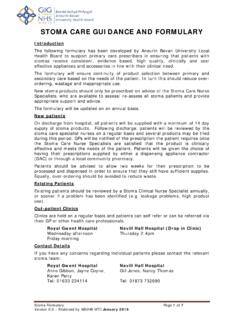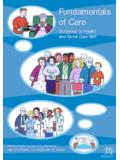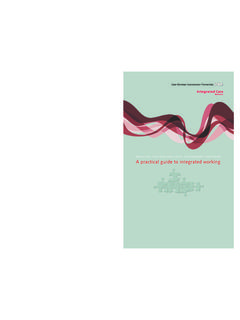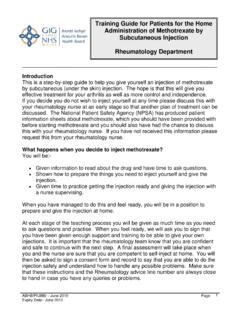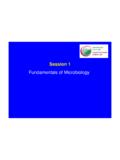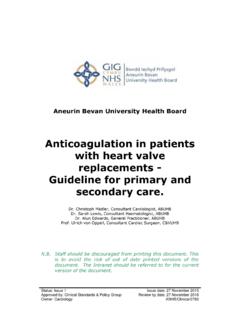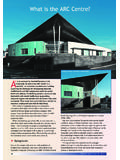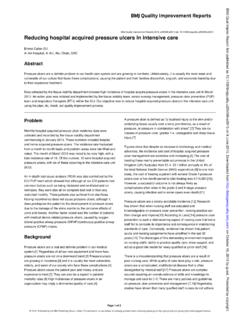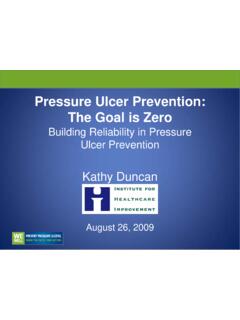Transcription of Reducing Hospital Acquired Pressure UlcersAcquired ...
1 Reducing Hospital Acquired Pressure UlcersAcquired Pressure UlcersPrevention & ManagementPrevention & Management of Pressure DamageSpreadthe Learning and celebrate the successesPrevalence & CostPrevalence & CostPlf10% t 18% i Prevalence ranges from 10% to 18% in the UK (Clark & Cullum 1993). Cost to patient - pain, extended Hospital stay and possible tid4 Cost of treating one grade 4 Pressure ulcer is estimated at 10,551 (2004) . Pressure ulcers, Pressure ulcers, Pressure sores & bedsoresA Pressure ulcer is localized injury to the skin and/or underlying tissue usually over a bony ygyyprominence, as a result of Pressure , or Pressure in combination with shear. A number of contributing or confounding factorsA number of contributing or confounding factors are also associated with Pressure ulcers; the significance of these factors is yet to be elucidatedelucidated.
2 EPUAP (2009)Common PlPressure ulcer locationsoca o s Sacrum 49% Hips11% Other 30 5% , spinal vertebrae scapulaevertebrae, scapulae, elbows and malleoli. (Collier 1995)()Causes of pressureCauses of Pressure ulcer development - External factors Pressure Shear Contributing factorsContributing factors Friction MoisturePressure damagePressure damage Occurs when skin and other tissues are Occurs when skin and other tissues are directly compressed between bone and another surface such as a bed or a chairanother surface such as a bed or a chair. Shutting off blood supply causing tissue to pressurecan cause damage - if over several pressurecan cause damageHigh pressurecan cause damage - within Skin moves at a different rate to underlying ttstructures Stretches skin surfaceSt etches Displaces and disto ts blood Stretches, Displaces and distorts blood : When a seated patient slips down in a chair or bedFrictionFriction Two surfaces move laterally across oneTwo surfaces move laterally across one another.
3 Causes SCUFF an break in the skin which can be infl enced b shea o p ess ecan be influenced by shear or , Faeces, Sweat, Exudate .. Increases friction and shearing forces which can lead to skin adhering to surfaceadhering to surface. of acute in-pt s are faecally incontinent(Junkin & Selekof 2007). 23% (ABMUHB West 2009) 23% (ABMUHB West 2009) 54% of all skin injury results from exposure to incontinence(Gray et al 2007).2007). times more likely to sustain Pressure damage that continent patientspSkin becomes water logged causing it to break down, lose its protective barrier and resulting a superficial sesCauses Internal factors General health and age Mobilityy Body weight-Impaired nutritional status Incontinence Incontinence Poor blood supply Insensitivity to pain or discomfort Medication Inadequate diet or fluid intakeSSurface In order to identify the correct ysurface we must 1stidentify the tit i kpatients riskRisk Assessment Comprise of a selection of identified intrinsic and fh blextrinsic factors that contribute to Pressure ulcer development risk.
4 Each are given a numerical value which once calculated reflects the degree of risk an individual has of developing Pressure damageindividual has of developing Pressure damage . Should be completed within 2 hours of admission and reviewed as individuals conditionadmission and reviewed as individuals condition changes (ABMULHB 2010)ACT ON RISK IDENTIFIEDSkiSkin assessment General medical condition. Including all bony prominences every time Including all bony prominences every time you clean or reposition the patient or at the very least every Is the surface assisting with protecting the patient ?patient ? Moistness and incontinence. Nutrition. What to LOOK for:What to LOOK for:Nblhid(hi ) Non-blanching redness (hyperaemia).
5 Purplish/bluish patches on dark skinned pppeople. Persistent red patches on light skinnedPersistent red patches on light skinned people Swelling Blisters Swelling, Blisters Shiny areas & Dry patches Cracks, calluses and wrinkles fSigns to FEEL for are: Localised hard areas. Localised warm warm Localised induration. Swollen skin over bony 1stsigns Blanching Erythema (redness)(redness)When lightly pressed the redness will turn white andturn white and then within a few secondfew second back to still present. Intact skin with non-blh bldfblanchable redness of a localized area usually over a bony prominencea bony prominence. Discoloration of the skin, warmth, edema, hardness ilbor pain may also be pigmented skinDarkly pigmented skin may not have visible blanching.
6 G Partial thickness loss of dermis presenting as apresenting as a shallow open ulcer with a red pinkwith a red pink wound bed, without slough. May also gypresent as an intact or open/ruptured serumfilled blisterserum-filled blister. Full thickness tissue loss. Subcutaneous fat may beSubcutaneous fat may be visible but bone, tendon or muscle arenotor muscle are notexposed. Some slough may be presentmay be present. Mayinclude undermining &tli& tunneling. Full thickness tissue loss with exposedloss with exposed bone, tendon or muscle Slough ormuscle. Slough or eschar may be presentOftenpresent. Ofteninclude undermining and CareNursing CareGeneral careGeneral care Nutrition Patient handlingSki Skin care Turning/repositioningg/ pg 30 degree tilt lf Pressure relief equipment inc.
7 CushionsKKeep moving Repositioning should be determined by Repositioning should be determined by the results of skin inspection Individuals at risk & are able to - should be encouraged to inspect their own skinbe encouraged to inspect their own skin and redistribute their own weight Cttbtbi Contact between bony prominences should be avoided KiKeep movingShd f i ih ld bi i i d Shear and friction should be minimised Manual handling devices should beManual handling devices should be utilised correctlyUf th 30 dtilt Use of the 30 degree tiltProvision of equipmentProvision of equipmentMattresses cushions moving & handling equipmentMattresses, cushions, moving & handling equipment should be allocated according to to consider SeatingSeatingPelvicAnteriorPosteriorPel vic ObliquityAnterior Pelvic TiltPosterior Pelvic TiltCorrect Seating gPositionTotal Body Weight DistributionDistribution75% Buttocks/Thighs19% Feet4% Trunk2% ArmsOther Synthetic Sheepskins Dh i Doughnut rings Water filled glovesWater filled glovesSHOULD NOT BE USEDA llevyn Heel dressings haveAllevyn Heel dressings have NOpressure relieving propertiesDON TS:DONTS: Massage affected skin Massage affected skin.
8 Apply Rubber glove filled with water. Apply talc. Relieve Pressure with pillows if on Pressure RELIEVING equipment !!!!ItiIncontinence Undertake a continence assessment Manage with appropriate aids (pads /Manage with appropriate aids (pads / conveen, catheter, flexi seal etc) Advise patient / carers with regard Advise patient / carers with regard skin care. f Regularly cleanse and use of barrier productsIf it is a Moisture LesionPatients still require Pressure reliefAs the presence of moistureAs the presence of moisture increases the risk of Pressure damage occurring (NICE 2005).NutritionNutrition Screen and assess nutritional status if individual at risk of/or as Pressure pdamage.)
9 Referindividuals with a Pressure ulcer to the dietitian for early assessment. Ath ttl ti titk (f dflidllt) Assessthe total nutrient intake (food, fluid, oral supplements). Provide30-35 kcalories/kg body weight and to grams protein/kg body weight daily for individuals with a Pressure ulcer. Provideoral supplements between meals if needed. Considernutritional support (enteral or parenteral nutrition) if oral intake is inadequateinadequate. Assess renal function to ensure that high levels of protein are appropriate for the individual. Provideand encourage adequate daily fluid intake for hydration. Monitorindividuals for signs and symptoms of is Better Than CurefEstimated cost of treating Pressure sores in the UK is estimated at as high as 750million 750milliondl?
10 Best way to avoid Pressure ulcers?MOVE!Patients position should be changed pgregularlyUnderstanding the causes of Pressure Ulcers is fdtliti thfundamental in preventing aids patient care and plays a significant role in Pressure ulcer - equipment is not a substitute for GOOD FUNDAMENTAL NURSING CAREI mplementingImplementing thethe SKIN BUNDLESKIN BUNDLE ModelPressure Ulcers and the Importance of Management Cost to patient Cost is around billion a yeary Actual Pressure Ulcer Incident % unknownunknown Cost of treating one grade 4 Pressure litit d t 10 551 (2004)ulcer is estimated at 10,551 (2004) Costs around 30,000 to treat a patient along the surgical pathwaySpreadthe Learning and celebrate the successes Content Area Drivers Interventions Understand the risk factors for acquiring Pressure ulcers Understand the local context & analyse local data to assess patients on ward/unit most at risk Utilise patient At risk cards to quickly identify Risk Identification Assess Pressure ulcer risk on admission for ALL patientsUtilise patient At risk cards to quickly identify those at increased risk Risk Assessment Reduce the Percentagepat e tsRe-assess skin every 8 hours where necessary Initiate and maintain correct and suitable preventative measures Reliable
